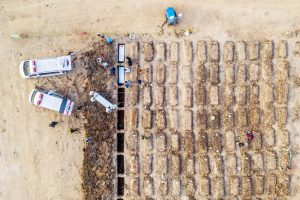Southeast Asian nations urgently need more help in securing adequate supplies of COVID-19 vaccines, as the region struggles to contain the world’s highest death toll from the virus, the International Federation of Red Cross and Red Crescent Societies said yesterday.
In the statement the Red Cross noted that the region has experienced 38,522 deaths from COVID-19 over the past two weeks, “nearly twice as many as North America.”
For most of 2020, Southeast Asia – particularly the mainland nations of Thailand, Vietnam, Laos, Cambodia, and Myanmar – earned global plaudits for their successful containment of the disease. In recent months, however, the highly contagious Delta variant of COVID-19 has prompted record outbreaks in most of the region, pushing fragile healthcare systems to the brink and exposing sluggish vaccination rollouts.
“This COVID-19 surge driven by the Delta variant is claiming a tragic toll on families across Southeast Asia and it’s far from over,” Alexander Matheou, Asia Pacific Director of the International Federation of Red Cross and Red Crescent Societies, said in the statement. “We fear that as the virus spreads from cities to regional and rural areas, many more lives will be lost among the unvaccinated.”
Vietnam, Thailand, Malaysia, and the Philippines, are all in the midst of record outbreaks of COVID-19. Yesterday, Malaysia reported a record of 22,242 cases of the disease, while Thailand announced 312 deaths, the second straight day of record.
While Indonesia passed the peak of its current wave of cases in July, it is still recording upwards of 20,000 infections per day, as cases spread from the virus epicenters on the islands of Bali and Java to the outer islands of the archipelago. It also recorded the most deaths – 1,128 – of any country in the world yesterday.
Meanwhile, the full extent of the public health emergency in Myanmar is hard to discern, given the turmoil that has descended on the country since the coup, prompting U.N. experts to call for an urgent humanitarian intervention to stave off further outbreaks.
But while some wealthy Western nations have fully vaccinated upwards of 60 percent of their populations, many of the worst-hit Southeast Asian nations lag behind in vaccination rollouts.
Some Southeast Asian nations have done fairly well on this front. Small, wealthy Singapore has fully vaccinated 71 percent of its population, followed closely by Cambodia (45 percent) and Malaysia (35 percent).
But Indonesia and Philippines, Southeast Asia’s two most populous countries, have only fully vaccinated 11 percent and 12 percent of their populations, respectively. Vietnam has fully vaccinated just 1.44 percent. Meanwhile, the health authorities in Myanmar have not reported vaccination data since June, when the country had inoculated just 3 percent of its population. (All of these figures are from the Our World In Data tracker.)
Describing the coming weeks as “critical,” Matheou called for “much greater efforts by richer countries to urgently share their millions of excess vaccine doses with countries in Southeast Asia. We also need vaccine companies to share technology and scale up production.”
While the pace of vaccinations is now beginning to pick up across Southeast Asia, the Red Cross statement offers a reminder of just how far the region has to go to reach the mass vaccination rates of 70-80 percent that are needed “if we want to win the race against [COVID-19] variants and overcome this global pandemic.” As it stands, the region’s COVID-19 trial looks set to extend well into 2022.

































